Quantifying Missed Opportunities for Cumulative Forest Road Carbon Storage over the Past 50 Years in the Boreal Forest of Eastern Canada
Abstract
1. Introduction
2. Materials and Methods
2.1. Study Area
2.2. Territory Characterization
- Forest cover composition: this indicates whether coniferous, deciduous, mixed stands, or other vegetation types cover the area.
- Ecological type: ecosystem classification including associations between vegetation, soil, and climate [30].
- Slope and drainage: measures of local topography and soil capacity to evacuate or retain water, influencing tree growth and soil stability.
- Forest productivity zone: the division of territories according to their climatic and edaphic conditions, which determine forest productivity.
- Logging, including fire salvage logging, which necessitates road construction.
- Commercial thinning.
- Other silvicultural activities, including soil preparation and planting.
2.3. Road Network Analysis
- Medium, corresponding to classes 03 and 04 (gravel roads for forestry operations).
- Narrow, corresponding to classes 05 and WI (lower-capacity roads still used in forestry).
- Unclassified, corresponding to classes UC and UN (roads without formal classification but present in forestry landscapes).
- 1
- The area occupied by roads at the time of planting, measured in hectares, representing the surface area directly affected by the complete road infrastructure structure, including the roadway and its right-of-way;
- 2
- The progressive reduction in road width due to the natural recovery of vegetation is expressed as a percentage [15].
- Short-term (0 to 10 years after cutting): around 1.6% of the surface is recovered.
- Medium-term (10 to 20 years): between 17% and 51%.
- Long-term (>20 years): between 40% and 82%.
2.3.1. Calculation of the Road Area
2.3.2. Evaluation Scenarios
- Scenario S0I0: no preparation of establishment conditions and no use of fast-growing species.
- Scenario S1I0: the preparation of establishment conditions was applied, but no fast-growing species were used.
- Scenario S0I1: No preparation of establishment conditions was applied, but fast-growing species were used.
- Scenario S1I1: Both the preparation of establishment conditions and fast-growing species were implemented.
2.3.3. Estimating Carbon in Reforested Areas
2.4. Statistical Analysis
3. Results
3.1. Performance of Modelling Approaches
3.2. Characterization of CS Dynamics on Forest Roads
3.2.1. CS by Road Category
3.2.2. Impact of Reforestation Scenarios on CS
4. Discussion
4.1. Analysis of Reforestation Scenarios
4.2. Operational Management and Connectivity
- Narrow and unclassified roads: These segments typically contribute minimally to the overall connectivity of the forest road network. Their deactivation can be prioritized as it does not significantly fragment the transportation network. Furthermore, these closures can contribute to ecological connectivity by reducing habitat fragmentation, although their contribution to species connectivity remains moderate.
- Medium roads: Owing to their width and available surface area, they offer a higher potential for enhancing habitat connectivity. However, their central role in forestry logistics requires careful planning to ensure that they remain functional for future harvesting rotations [12].
- Prioritize accessible areas with high CS potential.
- Gradually extend interventions to remote regions by adapting strategies as new data becomes available.
4.3. Temporality and Rotation Management
- Reduce soil disturbance;
- Minimize habitat fragmentation;
- Limit the expansion of road networks in managed forests.
4.4. Analysis of the CS Potential Mosaic
4.5. Methodological Limitations and Practical Implications
4.6. Strategic Planning and Prioritization of Reforestation Areas
5. Conclusions
Author Contributions
Funding
Data Availability Statement
Acknowledgments
Conflicts of Interest
Appendix A
| Years to Harvest | ||||||
|---|---|---|---|---|---|---|
| Scenario | Road Category | 0–20 | 21–40 | 41–60 | 61–100 | Total (ton × 103) |
| S0I0 | UNCLASSIFIED | 0 | 10 | 60 | 70 | 140 |
| S0I0 | NARROW | 0 | 10 | 60 | 100 | 170 |
| S0I0 | MEDIUM | 0 | 30 | 270 | 540 | 840 |
| Total S0I0 | 1150 | |||||
| S0I1 | UNCLASSIFIED | 0 | 50 | 310 | 240 | 60 |
| S0I1 | NARROW | 0 | 40 | 270 | 320 | 630 |
| S0I1 | MEDIUM | 10 | 110 | 750 | 1170 | 2040 |
| Total S0I1 | 3270 | |||||
| S1I0 | UNCLASSIFIED | 0 | 20 | 150 | 130 | 300 |
| S1I0 | NARROW | 0 | 20 | 140 | 210 | 370 |
| S1I0 | MEDIUM | 10 | 70 | 610 | 1060 | 1750 |
| Total S1I0 | 2420 | |||||
| S1I1 | UNCLASSIFIED | 0 | 110 | 690 | 430 | 1230 |
| S1I1 | NARROW | 10 | 90 | 660 | 650 | 1410 |
| S1I1 | MEDIUM | 20 | 230 | 1650 | 2260 | 4160 |
| Total S1I1 | 6800 | |||||
References
- FAO. The State of the World’s Forests 2022. In Forest Pathways for Green Recovery and Building Inclusive, Resilient and Sustainable Economies; FAO: Rome, Italy, 2022. [Google Scholar]
- Ryan, T.; Phillips, H.; Ramsay, J.; Dempsey, J. Forest Road Manual: Guidelines for the Design, Construction and Management of Forest Roads; COFORD: Dublin, Ireland, 2004. [Google Scholar]
- Thiffault, E.; Hannam, K.D.; Paré, D.; Titus, B.D.; Hazlett, P.W.; Maynard, D.G.; Brais, S. Effects of forest biomass harvesting on soil productivity in boreal and temperate forests—A review. Environ. Rev. 2011, 19, 278–309. [Google Scholar] [CrossRef]
- Thompson, M.P.; Gannon, B.M.; Caggiano, M.D. Forest Roads and Operational Wildfire Response Planning. Forests 2021, 12, 110. [Google Scholar] [CrossRef]
- Coffin, A.W. From roadkill to road ecology: A review of the ecological effects of roads. J. Transp. Geogr. 2007, 15, 396–406. [Google Scholar] [CrossRef]
- MRNF. Forest Harvesting Not a Cause of Deforestation in Quebec; MRNF: Québec, QC, Canada, 2022. [Google Scholar]
- Boston, K. The potential effects of forest roads on the environment and mitigating their impacts. Curr. For. Rep. 2016, 2, 215–222. [Google Scholar] [CrossRef]
- Caliskan, E. Environmental impacts of forest road construction on mountainous terrain. Iran. J. Environ. Health Sci. Eng. 2013, 10, 23. [Google Scholar] [CrossRef]
- Labelle, E.R.; Jaeger, D. Soil Compaction Caused by Cut-to-Length Forest Operations and Possible Short-Term Natural Rehabilitation of Soil Density. Soil Sci. Soc. Am. J. 2011, 75, 2314–2329. [Google Scholar] [CrossRef]
- St-Pierre, F.; Drapeau, P.; St-Laurent, M.-H. Drivers of vegetation regrowth on logging roads in the boreal forest: Implications for restoration of woodland caribou habitat. For. Ecol. Manag. 2021, 482, 118846. [Google Scholar] [CrossRef]
- Kolka, R.K.; Smidt, M.F. Effects of forest road amelioration techniques on soil bulk density, surface runoff, sediment transport, soil moisture and seedling growth. For. Ecol. Manag. 2004, 202, 313–323. [Google Scholar] [CrossRef]
- Nazari, M.; Arthur, E.; Lamandé, M.; Keller, T.; Bilyera, N.; Bickel, S. A Meta-analysis of Soil Susceptibility to Machinery-Induced Compaction in Forest Ecosystems Across Global Climatic Zones. Curr. For. Rep. 2023, 9, 370–381. [Google Scholar] [CrossRef]
- Mayer, M.; Prescott, C.E.; Abaker, W.E.; Augusto, L.; Cécillon, L.; Ferreira, G.W.; James, J.; Jandl, R.; Katzensteiner, K.; Laclau, J.P.; et al. Tamm Review: Influence of forest management activities on soil organic carbon stocks: A knowledge synthesis. For. Ecol. Manag. 2020, 466, 118127. [Google Scholar] [CrossRef]
- Lyons, C.K.; Borz, S.A.; Harvey, C.; Ramantswana, M.; Sakai, H.; Visser, R. Forest roads: Regional perspectives from around the world. Int. J. For. Eng. 2023, 34, 190–203. [Google Scholar] [CrossRef]
- Braham, N.; Valeria, O.; Imbeau, L. Characterization of Vegetation Dynamics on Linear Features Using Airborne Laser Scanning and Ensemble Learning. Forests 2023, 14, 511. [Google Scholar] [CrossRef]
- Kastridis, A. Impact of Forest Roads on Hydrological Processes. Forests 2020, 11, 1201. [Google Scholar] [CrossRef]
- Nave, L.E.; Walters, B.F.; Hofmeister, K.L.; Perry, C.H.; Mishra, U.; Domke, G.M.; Swanston, C.W. The role of reforestation in carbon sequestration. New For. 2019, 50, 115–137. [Google Scholar] [CrossRef]
- Xue, M.; Dai, M.; Li, H.; Deng, H.; Wang, S.; Sun, M.; Wang, Y. Understanding the benefits and challenges of harvested wood products in response to climate change. Resour. Conserv. Recycl. 2024, 209, 107739. [Google Scholar] [CrossRef]
- Wernick, I.K.; Kauppi, P.E. Storing carbon or growing forests? Land Use Policy 2022, 121, 106319. [Google Scholar] [CrossRef]
- Lefebvre, D.; Williams, A.G.; Kirk, G.J.; Paul; Burgess, J.; Meersmans, J.; Silman, M.R.; Román-Dañobeytia, F.; Farfan, J.; Smith, P. Assessing the carbon capture potential of a reforestation project. Sci. Rep. 2021, 11, 19907. [Google Scholar] [CrossRef]
- Ameray, A.; Bergeron, Y.; Cavard, X. Modelling the potential of forest management to mitigate climate change in Eastern Canadian forests. Sci. Rep. 2023, 13, 14506. [Google Scholar] [CrossRef]
- Ménard, I.; Thiffault, E.; Boulanger, Y.; Boucher, J.-F. Multi-model approach to integrate climate change impact on carbon sequestration potential of afforestation scenarios in Quebec, Canada. Ecol. Model. 2022, 473, 110144. [Google Scholar] [CrossRef]
- Kurz, W.A.; Dymond, C.C.; White, T.M.; Stinson, G.; Shaw, C.H.; Rampley, G.J.; Smyth, C.; Simpson, B.N.; Neilson, E.T.; Trofymow, J.A.; et al. CBM-CFS3: A model of carbon-dynamics in forestry and land-use change implementing IPCC standards. Ecol. Model. 2009, 220, 480–504. [Google Scholar] [CrossRef]
- Apps, M.J.; Kurz, W.A.; Beukema, S.J.; Bhatti, J.S. Carbon budget of the Canadian forest product sector. Environ. Sci. Policy 1999, 2, 25–41. [Google Scholar] [CrossRef]
- Ouranos. Ouranos: Regional Climatology and Adaptation to Climate Change. Available online: https://www.ouranos.ca/ (accessed on 25 May 2024).
- MRNF. Carte écoforestière à jour Provinciale, dans Données Québec, 2017, mis à jour le 28 Septembre 2023. Available online: https://www.donneesquebec.ca/recherche/dataset/carte-ecoforestiere-avec-perturbations (accessed on 15 January 2024).
- Robitaille, A.; Saucier, J. Paysages régionaux du Québec méridional. In Direction de la Gestion des Stocks Forestiers et Direction des Relations Publiques, Ministère des Ressources Naturelles du Québec; Publication du Québec: Québec, QC, Canada, 1998. [Google Scholar]
- Saucier, J.P.; Bergeron, J.F.; Grondin, P.; Robitaille, A. Les Régions Écologiques du Québec Méridional: Un des Éléments du Système Hiérarchique de Classification Écologique du Territoire mis au Point par le Ministère des Ressources Naturelles. 1998; pp. 1–12. Available online: https://www.researchgate.net/publication/330638545_Les_regions_ecologiques_du_Quebec_meridional_un_des_elements_du_systeme_hierarchique_de_classification_ecologique_du_territoire_mis_au_point_par_le_Ministere_des_Ressources_Naturelles (accessed on 2 February 2025).
- Turner, M. Landscape Ecology in Theory and Practice; Springer: New York, NY, USA, 2001. [Google Scholar]
- Bergeron, J.F.; Saucier, J.P.; Robert, D.; Robitaille, A. Québec forest ecological classification program. For. Chron. 1992, 68, 53–63. [Google Scholar] [CrossRef]
- Gouvernement du Québec. Adresses Québec: Guide de l’utilisateur; Gouvernement du Québec: Québec, QC, Canada, 2024. [Google Scholar]
- MRNF. Guide D’application du Règlement sur L’aménagement Durable des Forêts du Domaine de L’état; MRNF: Québec, QC, Canada, 2022. [Google Scholar]
- Girardin, P.; Valeria, O.; Girard, F. Measuring Spatial and Temporal Gravelled Forest Road Degradation in the Boreal Forest. Remote Sens. 2022, 14, 457. [Google Scholar] [CrossRef]
- Toms, S. ArcPy and ArcGIS–Geospatial Analysis with Python; Packt Publishing Ltd.: Birmingham, UK, 2015. [Google Scholar]
- Giasson, L.A.; Thiffault, E.; Lebel, L.; Carle, J.F. Carbon balance of forest management and wood production in the boreal forest of Quebec (Canada). Front. For. Glob. Change 2023, 6, 1242218. [Google Scholar] [CrossRef]
- Ameray, A.; Bergeron, Y.; Valeria, O.; Girona, M.M.; Cavard, X. Forest carbon management: A review of silvicultural practices and management strategies across boreal, temperate and tropical forests. Curr. For. Rep. 2021, 7, 245–266. [Google Scholar] [CrossRef]
- Pothier, D. Actualisation des Tables de Production Pour les Principales Espèces Forestières du Québec; Ministère des Ressources Naturelles, Forêt Québec: Québec, QC, Canada, 1998. [Google Scholar]
- Laflèche, V.; Bernier, S.; Saucier, J.; Gagné, C. Indices de Qualité de Station des Principales Essences Commerciales en Fonction des Types Écologiques du Québec Mé-Ridional; Ministère des Ressources naturelles (Provincial Department of Natural Resources): Quebec, QC, Canada, 2013. [Google Scholar]
- Jasinevičius, G.; Lindner, M.; Cienciala, E.; Tykkyläinen, M. Carbon Accounting in Harvested Wood Products: Assessment Using Material Flow Analysis Resulting in Larger Pools Compared to the IPCC Default Method. J. Ind. Ecol. 2018, 22, 121–131. [Google Scholar] [CrossRef]
- Johnston, C.M.; Radeloff, V.C. Global mitigation potential of carbon stored in harvested wood products. Proc. Natl. Acad. Sci. USA 2019, 116, 14526–14531. [Google Scholar] [CrossRef]
- Huang, J.; Tardif, J.C.; Bergeron, Y.; Denneler, B.; Berninger, F.; Girardin, M.P. Radial growth response of four dominant boreal tree species to climate along a latitudinal gradient in the eastern Canadian boreal forest. Glob. Change Biol. 2010, 16, 711–731. [Google Scholar] [CrossRef]
- Pinheiro, J.C.; Bates, D.M. Linear mixed-effects models: Basic concepts and examples. In Mixed-Effects Models in S and S-Plus; Springer: New York, NY, USA, 2000; pp. 3–56. [Google Scholar] [CrossRef]
- Bruce, P.; Bruce, A.; Gedeck, P. Practical Statistics for Data Scientists: 50+ Essential Concepts Using R and Python; O’Reilly Media: Sebastopol, CA, USA, 2020. [Google Scholar]
- Chen, T.; Guestrin, C. Xgboost: A scalable tree boosting system. In Proceedings of the 22nd ACM Sigkdd International Conference on Knowledge Discovery and Data Mining, San Francisco, CA, USA, 13–17 August 2016; pp. 785–794. [Google Scholar]
- Breiman, L. Random forests. Mach. Learn. 2001, 45, 5–32. [Google Scholar] [CrossRef]
- Stroup, W.W. Generalized Linear Mixed Models: Modern Concepts, Methods and Applications; CRC Press: New York, NY, USA, 2012. [Google Scholar]
- Zuur, A.F.; Ieno, E.N.; Walker, N.J.; Saveliev, A.A.; Smith, G.M. Mixed Effects Models and Extensions in Ecology with R; Springer: New York, NY, USA, 2009; Volume 574. [Google Scholar]
- Kohavi, R. A Study of Cross-Validation and Bootstrap for Accuracy Estimation and Model Selection; Morgan Kaufman Publishing: Burlington, MA, USA, 1995. [Google Scholar]
- Kuhn, M. Building Predictive Models in R Using the caret Package. J. Stat. Softw. 2008, 28, 1–26. [Google Scholar] [CrossRef]
- Wright, M.N.; Ziegler, A. Ranger: A fast implementation of random forests for high dimensional data in C++ and R. arXiv 2015, arXiv:1508.04409. [Google Scholar] [CrossRef]
- Kosicki, J.Z. Generalised Additive Models and Random Forest Approach as effective methods for predictive species density and functional species richness. Environ. Ecol. Stat. 2020, 27, 273–292. [Google Scholar] [CrossRef]
- Greener, J.G.; Kandathil, S.M.; Moffat, L.; Jones, D.T. A guide to machine learning for biologists. Nat. Rev. Mol. Cell Biol. 2022, 23, 40–55. [Google Scholar] [CrossRef] [PubMed]
- Segal, M.R. Machine Learning Benchmarks and Random Forest Regression; UCSF, Center for Bioinformatics and Molecular Biostatistics: San Francisco, CA, USA, 2004. [Google Scholar]
- Gouvernement du Québec. Loi sur L’aménagement Durable du Territoire Forestier; Les Publications du Quebec: Quebec, QC, Canada, 2024; Chapter A-18.1. [Google Scholar]
- Zhang, X.; Chen, J.; Dias, A.C.; Yang, H. Improving Carbon Stock Estimates for In-Use Harvested Wood Products by Linking Production and Consumption—A Global Case Study. Environ. Sci. Technol. 2020, 54, 2565–2574. [Google Scholar] [CrossRef]
- Nabiollahi, K.; Eskandari, S.; Taghizadeh-Mehrjardi, R.; Kerry, R.; Triantafilis, J. Assessing soil organic carbon stocks under land-use change scenarios using random forest models. Carbon Manag. 2019, 10, 63–77. [Google Scholar] [CrossRef]
- Chazdon, R.L. Beyond deforestation: Restoring forests and ecosystem services on degraded lands. Science 2008, 320, 1458–1460. [Google Scholar] [CrossRef]
- Lacerte, R.; Leblond, M.; St-Laurent, M.H. Determinants of vegetation regeneration on forest roads following restoration treatments: Implications for boreal caribou conservation. Restor. Ecol. 2021, 29, e13414. [Google Scholar] [CrossRef]
- Hunt, L.M.; Harvey, L.R.; Saunders, K.C. Managing Forest Road Access on Public Lands: A Conceptual Model of Conflict. Soc. Nat. Resour. 2009, 22, 128–142. [Google Scholar] [CrossRef]
- Öhman, K.; Lämås, T. Reducing forest fragmentation in long-term forest planning by using the shape index. For. Ecol. Manag. 2005, 212, 346–357. [Google Scholar] [CrossRef]
- Friedlingstein, P.; O’Sullivan, M.; Jones, M.W.; Andrew, R.M.; Bakker, D.C.E.; Hauck, J.; Landschützer, P.; Le Quéré, C.; Luijkx, I.T.; Peters, G.P.; et al. Global Carbon Budget 2023. Earth Syst. Sci. Data 2023, 15, 5301–5369. [Google Scholar] [CrossRef]
- Düthorn, E.; Schneider, L.; Günther, B.; Gläser, S.; Esper, J. Ecological and climatological signals in tree-ring width and density chronologies along a latitudinal boreal transect. Scand. J. For. Res. 2016, 31, 750–757. [Google Scholar] [CrossRef]
- Conway, D. Effects of Forest Equipment on Boreal Forest Soils: A Review. Bachelor’s Thesis, Faculty of Natural Resources Management, Lakehead University, Thunder Bay, ON, Canada, 2024. Available online: https://knowledgecommons.lakeheadu.ca/handle/2453/5327 (accessed on 10 February 2025).
- Kemppinen, J.; Niittynen, P.; Rissanen, T.; Tyystjärvi, V.; Aalto, J.; Luoto, M. Soil moisture variations from boreal forests to the tundra. Water Resour. Res. 2023, 59, e2022WR032719. [Google Scholar] [CrossRef]
- Pacheco, P.; Beatty, C.; Patel, J. An economic view on the costs and benefits of forest restoration. In Restoring Forests and Trees for Sustainable Development: Policies, Practices, Impacts, and Ways Forward; Oxford University Press: Oxford, UK, 2024; p. 238. [Google Scholar]
- Epstein, R.; Weintraub, A.; Sessions, J.; Sessions, B.; Sapunar, P.; Nieto, E.; Bustamante, F.; Musante, H. PLANEX: A system to identify landing locations and access. In Proceedings of the International Mountain Logging and 11th Pacific Northwest Skyline Symposium, Seattle, WA, USA, 10–12 December 2001; pp. 10–12. [Google Scholar]
- Walters, K.R. Design and development of a generalized forest management modeling system: Woodstock. In Proceedings of the International Symposium on Systems Analysis and Management Decisions in Forestry, Valdivia, Chile, 9–12 March 1993; pp. 190–196. [Google Scholar]
- St-Laurent, M.-H.; Boulanger, Y.; Cyr, D.; Manka, F.; Drapeau, P.; Gauthier, S. Lowering the rate of timber harvesting to mitigate impacts of climate change on boreal caribou habitat quality in eastern Canada. Sci. Total Environ. 2022, 838, 156244. [Google Scholar] [CrossRef] [PubMed]
- Environment and Climate Change Canada. Action Plan for the Woodland Caribou (Rangifer tarandus caribou), Boreal Population, in Canada—Federal Actions; Environment and Climate Change Canada: Ottawa, ON, Canada, 2018; pp. 7–28. [Google Scholar]
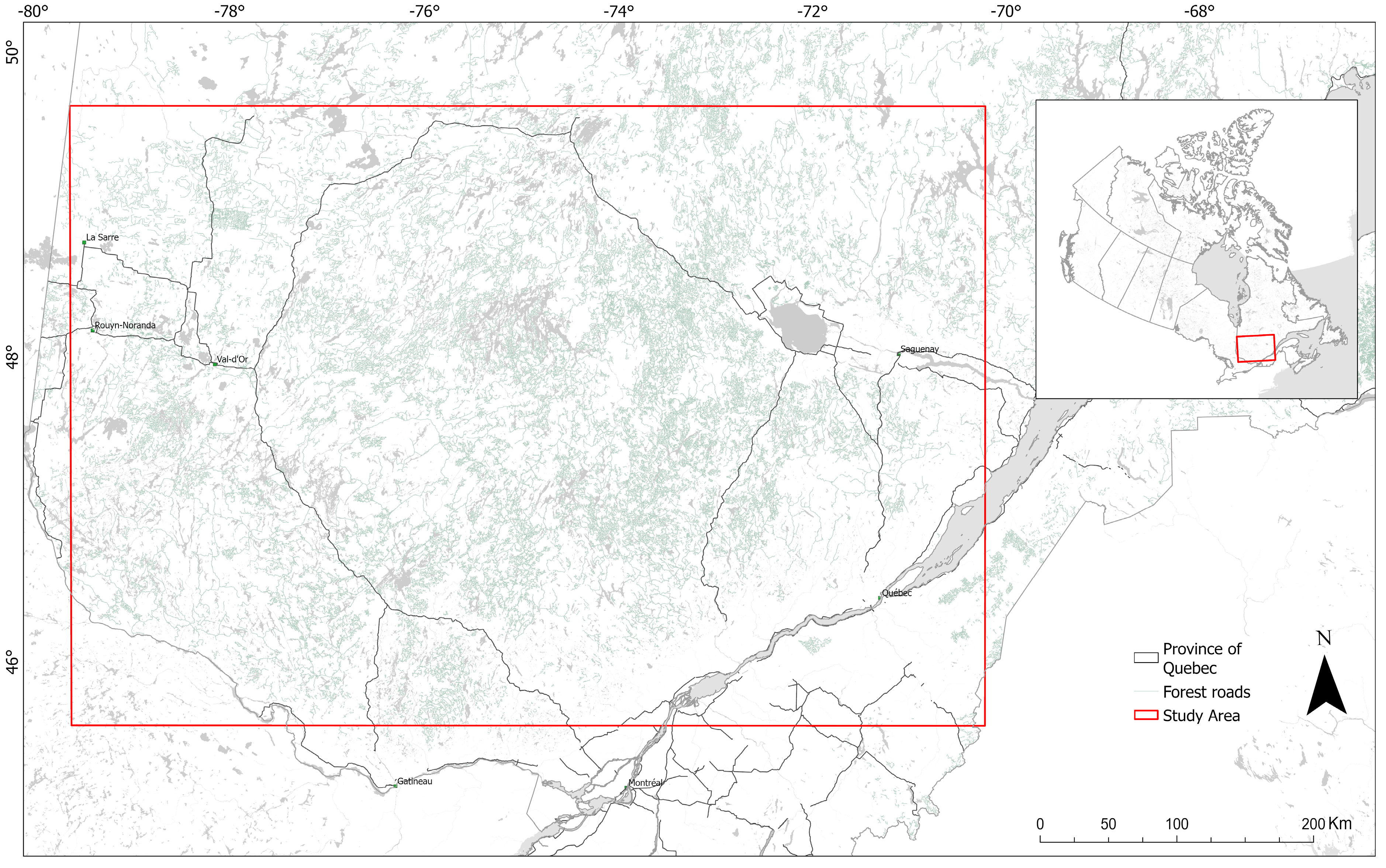
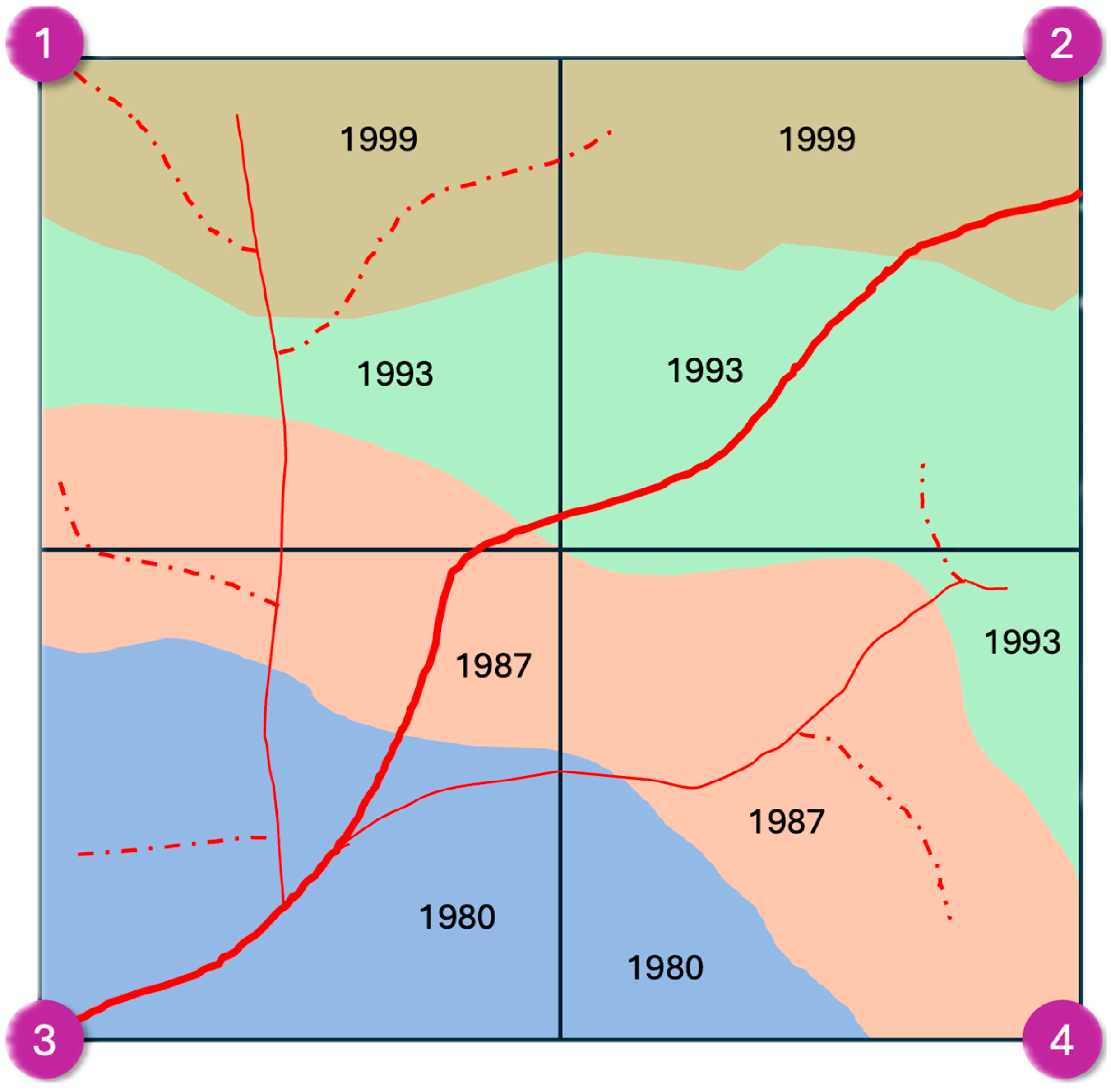
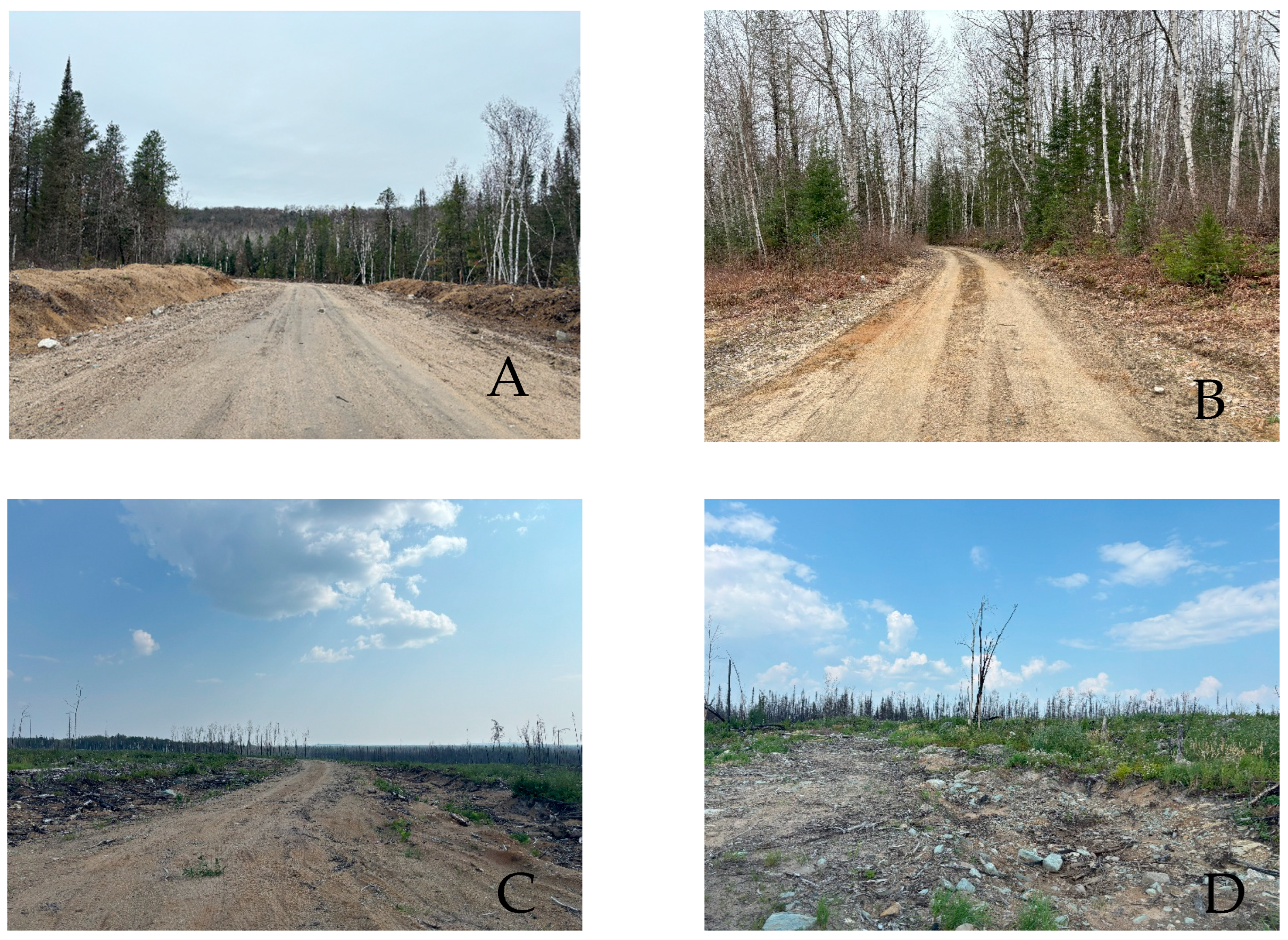
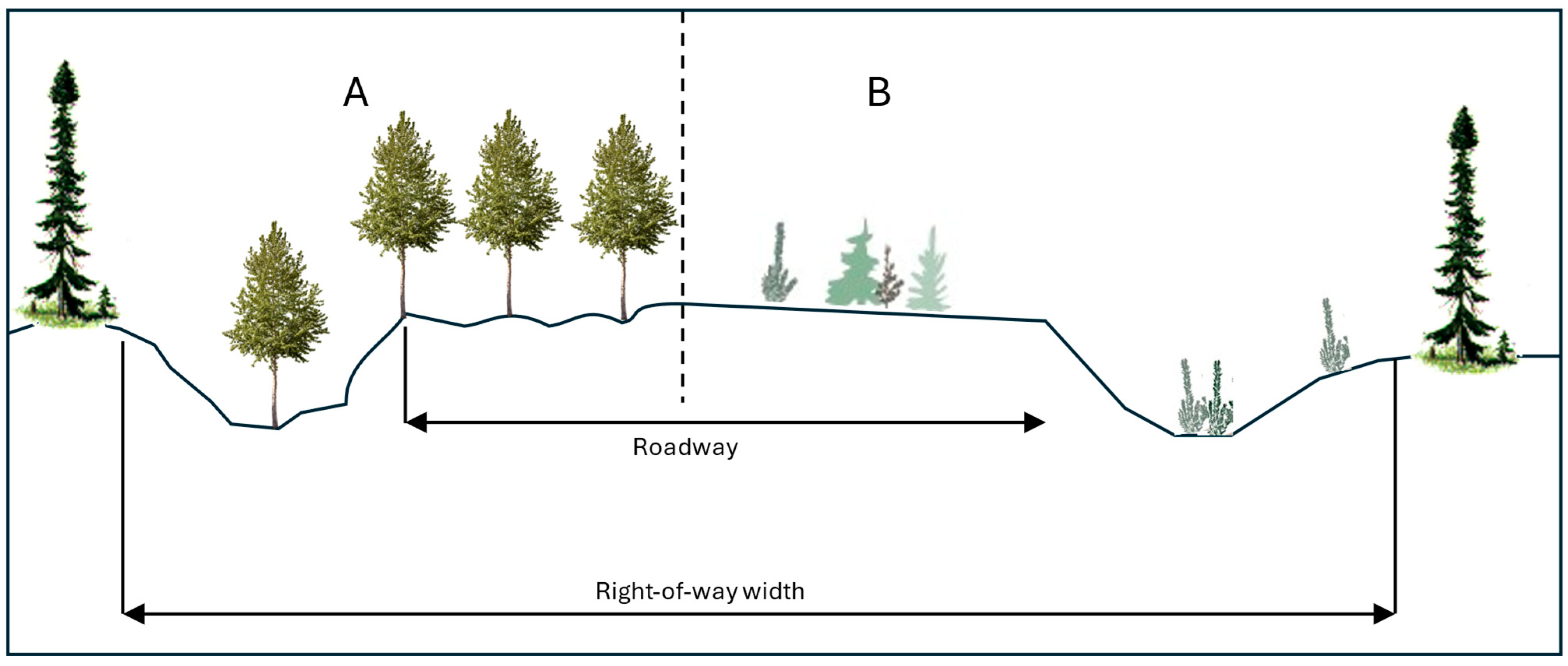
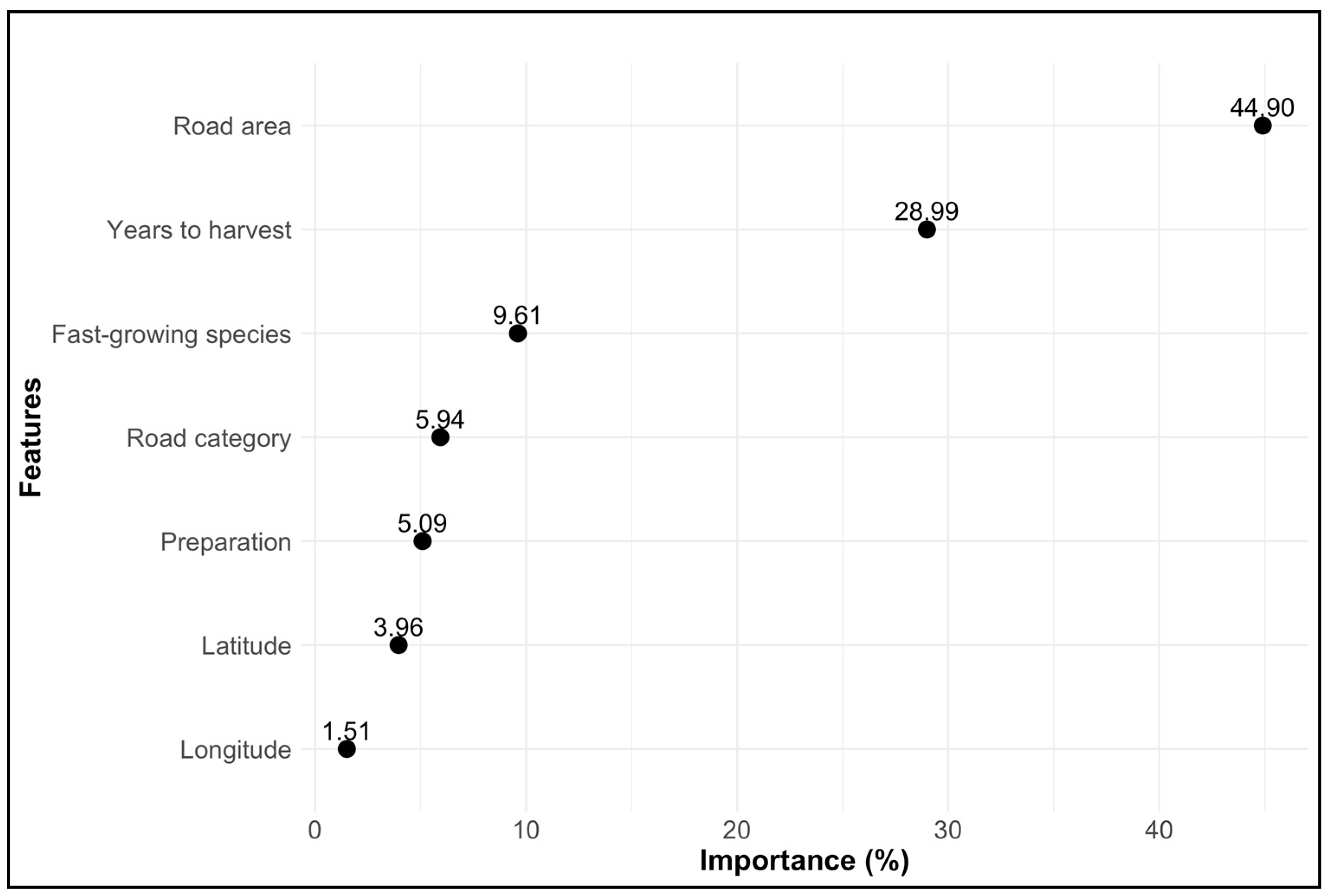

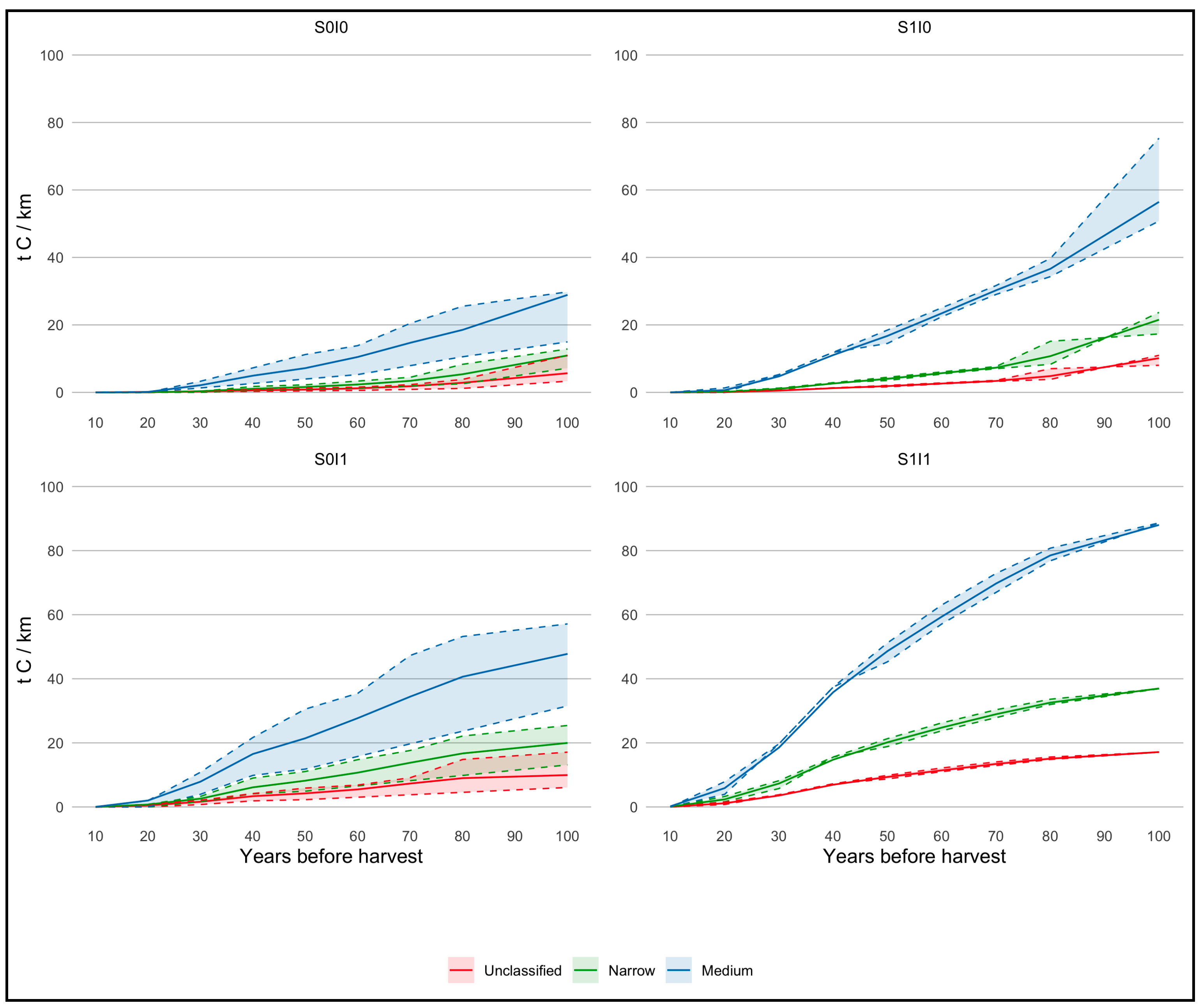
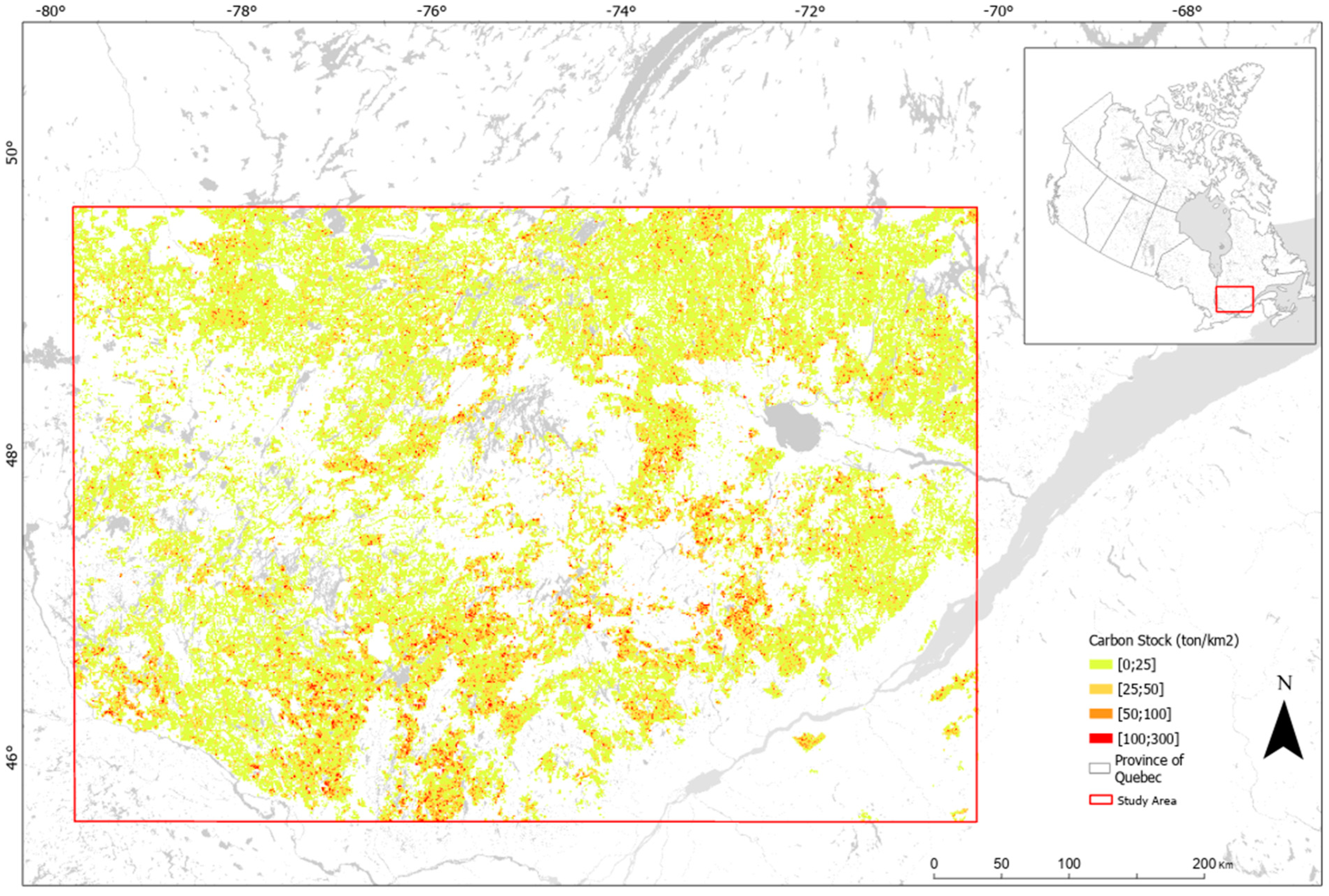
| Class | Road Surface | Category | Mean Width (m) | Surface Area (km2) | Total Length (km) | % of Total Road Length |
|---|---|---|---|---|---|---|
| 03 | Natural gravel | Medium | 19.7 | 532 | 26,965 | 9% |
| 04 | Mineral soil | Medium | 19.7 | 1362 | 69,133 | 23% |
| 05 | Mineral soil | Narrow | 8.2 | 212 | 26,293 | 9% |
| WI | Compacted snow | Narrow | 8.2 | 412 | 50,338 | 17% |
| UN | Unknown | Unclassified | 3.8 | 80 | 20,939 | 7% |
| UC | Unclassified | Unclassified | 3.8 | 421 | 110,770 | 36% |
| Total | 3019 | 304,438 | 100% |
| Model | RMSE | R2 | MAE |
|---|---|---|---|
| RF | 4.39 | 0.964 | 1.26 |
| XGBM | 4.48 | 0.963 | 1.60 |
| MARS | 7.63 | 0.892 | 4.68 |
| GAM | 14.48 | 0.610 | 8.99 |
| MLR | 14.54 | 0.607 | 9.01 |
| MM | 14.56 | 0.607 | 9.08 |
Disclaimer/Publisher’s Note: The statements, opinions and data contained in all publications are solely those of the individual author(s) and contributor(s) and not of MDPI and/or the editor(s). MDPI and/or the editor(s) disclaim responsibility for any injury to people or property resulting from any ideas, methods, instructions or products referred to in the content. |
© 2025 by the authors. Licensee MDPI, Basel, Switzerland. This article is an open access article distributed under the terms and conditions of the Creative Commons Attribution (CC BY) license (https://creativecommons.org/licenses/by/4.0/).
Share and Cite
Vega Escobar, A.; Girard, F.; Valeria, O. Quantifying Missed Opportunities for Cumulative Forest Road Carbon Storage over the Past 50 Years in the Boreal Forest of Eastern Canada. Forests 2025, 16, 688. https://doi.org/10.3390/f16040688
Vega Escobar A, Girard F, Valeria O. Quantifying Missed Opportunities for Cumulative Forest Road Carbon Storage over the Past 50 Years in the Boreal Forest of Eastern Canada. Forests. 2025; 16(4):688. https://doi.org/10.3390/f16040688
Chicago/Turabian StyleVega Escobar, Alejandro, François Girard, and Osvaldo Valeria. 2025. "Quantifying Missed Opportunities for Cumulative Forest Road Carbon Storage over the Past 50 Years in the Boreal Forest of Eastern Canada" Forests 16, no. 4: 688. https://doi.org/10.3390/f16040688
APA StyleVega Escobar, A., Girard, F., & Valeria, O. (2025). Quantifying Missed Opportunities for Cumulative Forest Road Carbon Storage over the Past 50 Years in the Boreal Forest of Eastern Canada. Forests, 16(4), 688. https://doi.org/10.3390/f16040688






